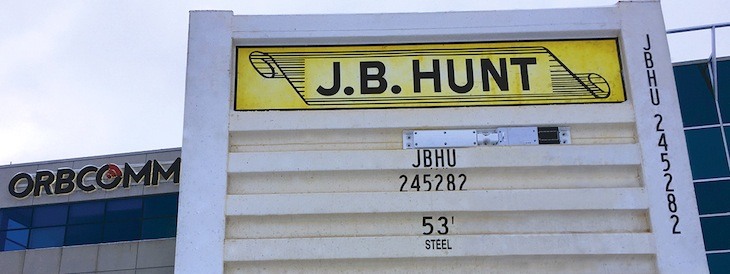J.B. Hunt’s intermodal capacity tapped as stock surges to 52-week high
by September 24, 2017 5:15 pm 1,868 views

J.B. Hunt Transport Service has deployed all of its 86,000 intermodal containers, has had its dedicated segment “hitting on all cylinders,” and shifted the mix in its brokerage division toward spot market demand, from contract business, said John Larkin, transportation analyst for Stifel.
On Friday (Sept. 22), J.B. Hunt shares (NASDAQ: JBHT) hit a 52-week high of $105.92 before closing at $105.75, up $1.08 or 1.03%.
Capacity of the Lowell-based carrier’s intermodal segment, which accounted for 67% of the company’s operating income in the second quarter, is tapped as a lack of warehouse capacity and has led some shippers to use the containers as temporary warehouses.
“This trend exacerbates an already challenging capacity environment,” Larkin said.
Larkin recently visited with J.B. Hunt senior management in Northwest Arkansas, “a broad array of truckers” at the Iowa Motor Truck Association Annual Meeting in Des Moines and “a variety of companies” at the Intermodal Association of North America Annual Meeting in Long Beach, Calif.
J.B. Hunt’s Dedicated Contract Services segment, its second largest by operating income, “is hitting on all cylinders and continues to be a leader in facilitating private fleet conversions,” according to Larkin. “The division continues to shy away from generic dry-van dedicated business, preferring instead to provide specialized equipment deployed in difficult to serve markets. Its competitors tend to be the Ruan’s, Ryder’s, Cardinal’s and Penske’s of the world” instead of dry-van truckload carriers.
The company often provides additional services to its core offering, including “multi-stop operations, loading, unloading, packaging (and) tagging,” he said. “The company believes these deals are more defensible and are more likely to consistently achieve the company’s deal specific ROIC (return on invested capital) targets.”
Its Integrated Capacity Solutions, or brokerage division, has shifted its business mix from contract business to a heavier mix of spot business.
“Spot market pricing is currently robust,” Larkin said. Margins should improve from the second quarter of 2017’s “disappointing result.” In the second quarter that ended June 30, the segment reported a $200,000 loss. Revenue rose 9% to $222 million.
Meanwhile, contract rate increases likely won’t benefit J.B. Hunt until the third quarter of 2018 “as most of Hunt’s customers won’t be asked for rate increases until after their contracts are up for renewal over the next six to nine months,” according to Larkin.
For its $500 million investment into technology, the company looks to be “on the short list of companies able to offer customers dynamic, continuously optimized transportation management services.” The company expects other businesses will be successful in this, too, but the investment will allow the company to remain a leader in solving customers’ supply chain challenges.
However, without a revenue generation model related to the investment, “it is challenging to gauge the return the company expects to earn on this initiative,” Larkin said. “But with the company focused on ROIC for all its capital deployed, one would assume that similar rigor has been applied in this case, recognizing, of course, that IT investment benefits are almost always the most challenging to estimate.”
Since May 17, J.B. Hunt’s stock has been on an upward trajectory, rising from a low of $83.45. In the past 52 weeks, the lowest it had traded at was $76.20. On Oct. 13, J.B. Hunt is expected to announce third-quarter 2017 earnings.
